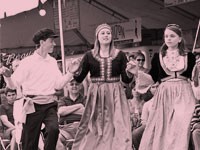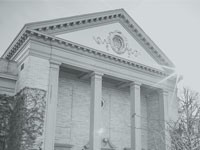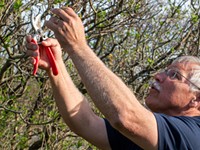
[
{
"name": "500x250 Ad",
"insertPoint": "5",
"component": "15667920",
"parentWrapperClass": "",
"requiredCountToDisplay": "1"
}
]
Ten things you may not know about Highland Park
Rochester's Highland Park may be known best as the site of the annual Lilac Festival in May, but the 150-acre park offers lots of year-round interest, including a ramble through Lamberton Conservatory and the arboretum, a variety of memorials and monuments, a castle with Sunken Gardens, free summertime performances of Shakespearean theater, free movie screenings, sports and recreation, and stunning views of the city. Read on to learn 10 pieces of arcane history and bits of surprising trivia about the floral forest on the hill.
Highland Park Neighborhood resident Michael Tomb enthusiastically helped with the research of this piece, particularly regarding George Ellwanger and Patrick Barry's contributions to Rochester.
1. Highland...cemetery? Long before it was a designated park, the area where the Lilac Festival is now held was, in the 19th century, home to the Monroe County Almshouse, Insane Asylum, and Penitentiary. Though no formal records of burials exist, there were periodic but little-known uncoverings of bones in the park, which were typically returned unceremoniously to the ground. On July 25, 1984, six skeletons were disinterred by a bulldozer landscaping the park, and six more were uncovered by following rainstorms.
An archaeological excavation by the Rochester Museum and Science Center began to relocate the bodies and determine the perimeters of the cemetery, which turned up scores more skeletons. In less than a month, more than 300 graves were excavated, but since 19 of the skeletons were too deep to be disturbed by landscaping, only 296 skeletons of men, women, and children were relocated to Mt. Hope Cemetery.
So, 19 skeletons were left in the park, right? Well, it turns out that the excavation was far from complete. Test holes and soil analysis indicate the burial ground was much larger than previously thought. It's estimated that 600 to 700 people remain buried in Highland Park to this day.
2. One of the best sledding hills in the city is manmade. The hills that make up Highland Park (and Pinnacle Hill, Cobbs Hill, and Mount Hope Cemetery) are part of the Pinnacle Range, formed by debris deposited during the late stages of the last glacial retreat, about 12,000 years ago. A large portion of the terrain is made up of layers of gravel and sand deposits.
The terrain is broken up by natural valleys created by kettles (depressions left on the landscape from large, slow-melting blocks of glacial ice), as well as numerous gullies formed by old gravel quarries. Quarrying created the valley behind Highland Park's Lamberton Conservatory, which is the site of some excellent sledding in winter and is carpeted with flowers in the springtime.
3. Highland is the Frederick Douglass statue's second site. Highland Bowl is home to a bronze monument to abolitionist, journalist, orator, and longtime Rochester resident, Frederick Douglass. This statue was the first monument to an African-American citizen in the country. When the sculpture, created by Sidney W. Edwards, was dedicated in 1899, it originally stood at the New York Central Train Station at Central Avenue and St. Paul Street. It was moved to Highland Park on September 4, 1941, after it was decided that the statue deserved a more peaceful setting.
The statue now overlooks Highland Bowl, just down the road from School No. 12, which is built on the site of Douglass' South Avenue home (where he lived from 1852 until a fire of suspicious origin burned it down in 1872). The home also served as a stop for the Underground Railroad. After the fire, Douglass bitterly relocated to the nation's capital, never to return until his funeral services. Because the statue was sculpted after his death, the eight-foot-tall monument was modeled after the likeness of Douglass' son, Charles.
4. Speaking of monuments... Highland Park is the site of quite a few memorials and monuments, including the Greater Rochester Vietnam Veterans Memorial, a two-acre space located in Highland Park South, the topography of which was sculpted to create landforms typical of rural Vietnam. The memorial includes flags of the United States, for each of the military branches, and one for POWs; a carved-stone map of the world; a garden for reflection; a walk of honor; a Medal of Honor grove of trees; a learning center; and a veterans garden with a sculpture of a soldier walking into a polished black granite wall.
Opposite Lamberton Conservatory, the Poet's Garden is a woodland garden with stone benches inscribed with Shakespearian quotes. The area was planted in 1916 in commemoration of the 300th anniversary of Shakespeare's death. The garden also features a stylized bronze bust of German philosopher and author Goethe, created in 1950 by William E. Ehrich in honor of the writer's 200th birthday.
The AIDS Remembrance Garden is just east of the Vietnam Veterans Memorial and includes a small garden within a stand of trees and a sculpture. The park also includes a Crime Victims' Rights Memorial and a Workers' Rights Memorial.
5. The park that almost wasn't. Highland Park is part of a greater, city-wide park system, and only one of four systems in the nation designed by internationally renowned landscape architect Frederick Law Olmsted. The first 20 acres of Highland Park were gifted to the city by pioneer horticulturalists and entrepreneurs George Ellwanger and Patrick Barry in 1887, but two early attempts by Ellwanger and Barry to donate the land were rejected by the Rochester City Council. Reasons for the rejection included that it would be a tax drain on the city, and that no one but those neighboring the park would use the space — tell that to the half a million annual visitors who visit the Lilac Festival.
The next roadblock was Olmsted's initial reluctance to take the design commission. The land lacked a free flowing water element, which he believed to be essential to good park design. He expressed his desire to develop two parks along the Genesee River, connected by a series of tree-lined boulevards, but the Commission responded that he could design all of the parks or none. In the end, Olmstead relented and got to work.
6. Highland Park was for the children. When the park was dedicated in the autumn of 1890, the Ellwanger & Barry Memorial Pavilion was dedicated to the children of Rochester. Ellwanger's presentation address, read by his son to an audience of 10,000 people (one half of which were kiddos, released from school for the occasion), stated that though the unplanted grounds were currently rough, they would soon be planted with trees, shrubs, and flowers, "affording to all, more especially to the children of the city, a healthful and agreeable place of recreation." These sentiments emerged from a time when Americans were developing stronger ideas about the importance of play and recreation for youth, and child labor laws were being established.
7. So...where's that pavilion today? The three-story, wooden, circular structure became known as the Children's Pavilion, and stood until the 1960's, when it seemed to be en vogue to rip down Rochester's historic buildings. Many structures original to the park were lost over time, including a refectory at the pinnacle, an herbarium building in the pinetum, and propagation greenhouses along the Goodman Street extension.
Today, the Highland Park Conservancy group is dedicated to the preservation of Highland Park's heritage, the promotion of its resources, and have formed a committee to rebuild the lost Children's Pavilion as the centerpiece of the park.
8. Not. Just. Lilacs. You could call Highland Park a collection of botanic collections. In addition to more than 1,200 lilac shrubs of 500 varieties, the park has a Japanese maple collection; 35 varieties of magnolia; a barberry collection; a rock garden with dwarf evergreens; 700 varieties of rhododendron, azalea, mountain laurel, and andromeda; horse chestnuts; spring bulbs and wildflowers; and a number of exotic trees. There's even a small American chestnut that remains on the grounds, clinging to life.
The park also features an oval pansy bed "carpet" of 10,000 plants, arranged in a new pattern each year; and an iris garden, given as a gift from Rochester's sister city of Hamamatsu, Japan.
9. Blossoms in February? It might not seem possible (especially after this last February), but something is nearly always in bloom in Highland Park. Seasonal fluctuations alter blooming schedules year-to-year, but check out the handy guide to the blossoming plant collections on Highland Park Conservancy's site and go four-season flower-hunting. Late May is definitely boom-time for buds, but the sweet-smelling witch-hazels bloom in February and March, their sunny hue brightening up a dreary mid-winter walk. If you've just gotta have the greenery in December and January, pop into the tropical room in Lamberton for an injection of humid glory.
10. Okay, here's some lilac trivia. The oldest still-growing lilac bush in Highland Park is a double lilac of the President Grevy variety, planted in 1897. It replaced one of the same variety that was planted in 1892 but removed. Because these plants are historic and special, there is a fine of $25 for picking lilacs in Highland Park. Many lilac varieties have been named for presidents and other dignitaries over time, and flowers from Highland Park have been presented to famous folks, including Queen Elizabeth II of England in 1954.
In This Guide...
Speaking of...
Latest in Festivals Preview
More by Rebecca Rafferty
-

Beyond folklore
Apr 4, 2024 -

Partnership perks: Public Provisions @ Flour City Bread
Feb 24, 2024 -

Raison d’Art
Feb 19, 2024 - More »











